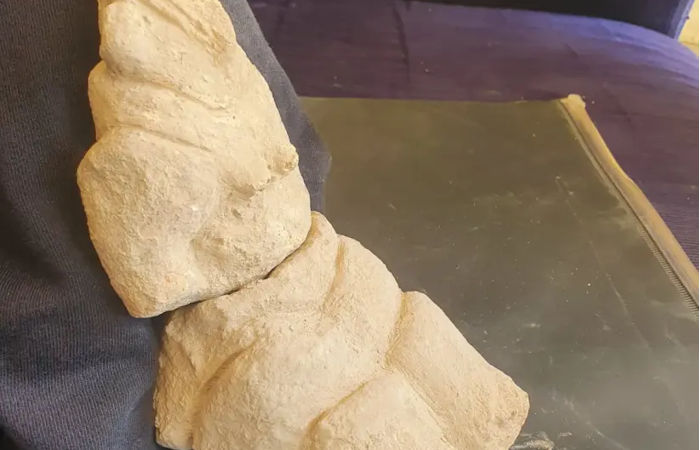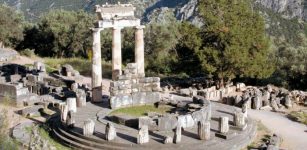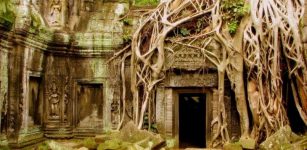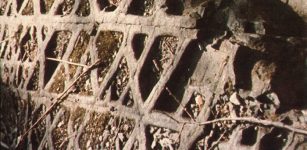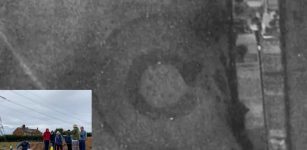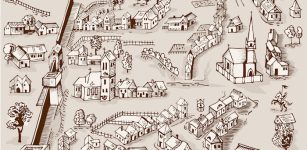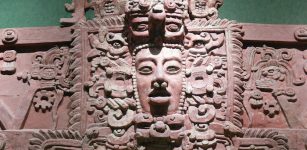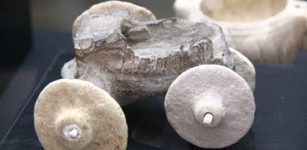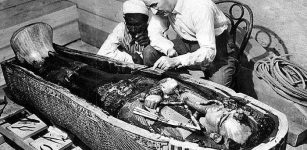8,000-Year-Old Yarmukian ‘Mother Goddess’ Figurine Discovered In Israel
Jan Bartek - AncientPages.com - Archaeologists have unearthed an 8,000-year-old Yarmukian 'Mother Goddess' figurine at Sha’ar HaGolan in Israel.
The 20-centimeter figurine was discovered broken in two pieces next to the wall of a home, said excavation co-director Anna Eirikh-Rose, Israeli Antiquity Authority Judea district archaeologist, who is doing her doctoral research at the Hebrew University on Neolithic pottery.
An impressive 8,000 year old Yarmukian ceramic "Mother Goddess" figurine was uncovered at renewed excavations at the Sha'ar HaGolan Yarmukian archaeological site. Photo credit: Anna-Eirikh Rose
The Yarmukian Culture is a Neolithic culture of the ancient Levant. The Yanukians lived in the region long before the Crusader Kingdom of Jerusalem, the Kingdom of Israel and the Kingdom of Judah existed. Over the years archaeologists have unearthed several Yarmukian settlements making it possible to gain knowledge about this Neolithic culture.
“The Yarmukian population was semi nomadic and pastoralist, occupying the sites only part of the time. It was suggested that they lived in subterranean pits and rounded huts made of perishable materials. The art objects aside (13), all other aspects of this material culture such as pottery, architecture or economy were almost unknown.” 1
“It is one of the oldest cultures in the Levant to make use of ceramic pottery, with a distinctive style of herringbone decorations incised in horizontal and diagonal lines over the body of their ceramic cooking, serving and storage vessels.
The culture is also known for its enigmatic and iconic “Mother Goddess” figurines, which are believed to have been part of a Yarmukian fertility cult,” the Jerusalem Post reports.
Archaeologists have previously unearthed “Mother Goddess” figurines varying in size. Some of these artifacts have been large.
Scientists are confident Mother Goddess was part of a Yarmukian fertility cult.
The excavation is being carried out in conjunction with the French Center for Research in Jerusalem under the co-direction of Dr. Julien Vieugue.
“This woman ceramic figurine is a hallmark of Yarmukian culture,” said excavation co-director Anna Eirikh-Rose, Israeli Antiquity Authority Judea district archaeologist, who is doing her doctoral research at the Hebrew University on Neolithic pottery. “This is one of the largest examples of the figurine found. It is of a large, seated woman with big hips, a unique pointed hat and what is known as ‘coffee-bean’ eyes and a big nose. One hand is positioned on her hip and the other one under her breast.”
“Though dubbed “coffee-bean” eyes, the traditional eyes of the figurine more likely represented kernels possibly of wheat, or more likely barley, she said.
All the small details of the figurine are important for its cultic symbolism, she said, and the process of creating such a figurine involved a complex method of wrapping and layering the clay around a central cylindrical core.
“It is really impressive, and was a very elaborate way of making a figurine,” she said. “It was not simple to make.”
The Yarmukian culture was poised at the dramatic human juncture of the transition from a foraging culture to a permanent settlement, which also changed the development of architecture. It was so named for the discovery of the archaeological remains at the Sha’ar Hagolan site dated to 6,400-6,000 BCE near the northern bank of the Yarmuk River in the central Jordan Valley,” the Jerusalem Post reports.
Eirikh-Rose emphasized that 8,000 years ago, the inhabitants of this site began to use pottery vessels and mass-produce them.
“This is the first culture of the Neolithic revolution to use and manufacture pottery vessels on a large scale, not just one bowl here and one bowl there,” she said.
As reported by the Jerusalem Post, “previous excavations at the Sha’ar Hagolan site have uncovered planned streets, courtyard houses and smaller mother goddess figurines, as well as incised pebble face figurines and eye figurines.
At its height, the settlement covered an area spanning 20 hectares, making it one of the largest settlements in the world at that time, said Eirikh-Rose. Although other Yarmukian sites have been identified since, Sha’ar Hagolan is the largest, probably indicating its role as a Yarmukian cultural center.
Eirikh-Rose said the newly uncovered figurine will be taken for residue analysis, which will help researchers establish what types of clay were used to create it. Continued study of these figurines may also help researchers in their quest to determine whether the “Mother Goddess” was used in cultic practices or was already part of established religion.
“There are so many theories,” she said. “This is a big question to study– the development of religious beliefs and culture.”
Written by Jan Bartek - AncientPages.com Staff Writer
Expand for references
